重庆医科大学:《护理学基础》课程教学资源(授课教案)第十二章 病人的清洁卫生
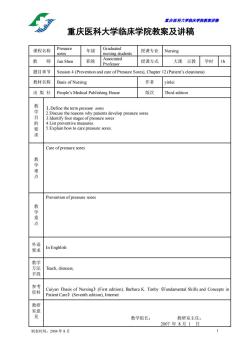
置庆医科大学脑床学院讲满 重庆医科大学临床学院教案及讲稿 课程名称 年级Graduated 授课专业Nursing ursing students 教师Jun Shen职称oac 授课方式 大课示教学时h 题目章节Session4(Prevention and care of Pressure Sores,)Chapter12(Patient's cleaniness) 教材名称Basis of Nursing 作者 yinlei 出版社People's Medical Publishing House 版次 Third edition 1.Define the term pressure sores wto care pressure sores Care of pressure sores 教学难点 Prevention of pressure sores 教学重 外语 要求 In Enghlish 教学 方法 Teach,disscuss, 手段 参 资料 Cuiyan basis of Nursing(First edition)Barbara K.Timby (Fundamental Skills and Concepts in Patient Care(Seventh edition),Internet 教学组长: 教研室主任: 2007年8月1日 制表时间:2004年8月
重庆医科大学临床学院教案讲稿 制表时间:2004 年 8 月 1 重庆医科大学临床学院教案及讲稿 课程名称 Pressure sores 年级 Graduated nursing students 授课专业 Nursing 教 师 Jun Shen 职称 Associated Professor 授课方式 大课 示教 学时 1h 题目章节 Session 4 (Prevention and care of Pressure Sores), Chapter 12 (Patient’s cleaniness) 教材名称 Basis of Nursing 作者 yinlei 出 版 社 People’s Medical Publishing House 版次 Third edition 教 学 目 的 要 求 1.Define the term pressure sores 2.Discuss the reasons why patients develop pressure sores. 3.Identify four stages of pressure sores 4.List preventive measures. 5.Explain how to care pressure sores. 教 学 难 点 Care of pressure sores 教 学 重 点 Prevention of pressure sores 外语 要求 In Enghlish 教学 方法 手段 Teach, disscuss, 参考 资料 Cuiyan《basis of Nursing》(First edition), Barbara K. Timby《Fundamental Skills and Concepts in Patient Care》(Seventh edition), Internet 教研 室意 见 教学组长: 教研室主任: 2007 年 8 月 1 日
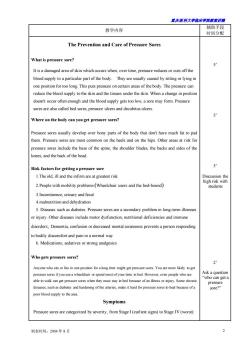
露庆医科大学临床半蕊裁案讲满 教学内容 辅助手段 时间分配 The Prevention and Care of Pressure Sores What is pressure sore? 5 It isa damaged area of skin time,pressure reducesor cuts offthe blood supply to a particular part of the body.They are usually caused by sitting or lying in one position for too long This puts pressure oncertain areas of the body.The pressure can reduce the blood supply to the skin and the tissues under the skin.When a change in positior doesn't occur often enough and the blood supply gets too low,asore may form.Pressure sores are also called bed sores.pressure ulcers and decubitus ulcers. 5 Where on the body can you get pressure sores? Pressure sores usually develop over bony parts of the body that don't have much fat to pad them.Pressure sores are most common on the heels and on the hips Other areas at risk for include the base of the spine.the shoulder blades.the backs and sides of th knees.and the back of the head. 5 Risk factors for getting a pressure sore 1.Theold,ill and the infirm are at greatest risk 2.People with mobility problems(Wheelchair users and the bed-bound) 3.Incontinence;urinary and fecal 4.malnutrition and dehydration 5.Diseases such as diabetes.Pressure sores are a secondary problem in long-term illnesses rinjury.Other diseases include motor dysfunction,deficiencies and immune disorders;Dementia.confusionor decreased mental awareness prevents a person responding obodily discomfort and pain in a normal way 6.Medications,sedatives or strong analgesics Who gets pressure sores? 2 Anyone who sits or lies in one position for a long time might get pressure sores.You are more likely to get Ask a question an get p ores when t diseases,such as diabetes and hardening of the arteries,make it hard for pressure sores oheal because of a sore? poor blood supply to the area. Symptoms Pressure sores are categorized by severity,from Stage I(earliest signs)to Stage IV(worst): 制表时间:2004年8月
重庆医科大学临床学院教案讲稿 制表时间:2004 年 8 月 2 教学内容 辅助手段 时间分配 The Prevention and Care of Pressure Sores What is pressure sore? It is a damaged area of skin which occurs when, over time, pressure reduces or cuts off the blood supply to a particular part of the body. They are usually caused by sitting or lying in one position for too long. This puts pressure on certain areas of the body. The pressure can reduce the blood supply to the skin and the tissues under the skin. When a change in position doesn't occur often enough and the blood supply gets too low, a sore may form. Pressure sores are also called bed sores, pressure ulcers and decubitus ulcers. Where on the body can you get pressure sores? Pressure sores usually develop over bony parts of the body that don't have much fat to pad them. Pressure sores are most common on the heels and on the hips. Other areas at risk for pressure sores include the base of the spine, the shoulder blades, the backs and sides of the knees, and the back of the head. Risk factors for getting a pressure sore 1.The old, ill and the infirm are at greatest risk 2.People with mobility problems (Wheelchair users and the bed-bound) 3.Incontinence; urinary and fecal 4.malnutrition and dehydration 5. Diseases such as diabetes. Pressure sores are a secondary problem in long-term illnesses or injury. Other diseases include motor dysfunction, nutritional deficiencies and immune disorders; Dementia, confusion or decreased mental awareness prevents a person responding to bodily discomfort and pain in a normal way 6. Medications; sedatives or strong analgesics Who gets pressure sores? Anyone who sits or lies in one position for a long time might get pressure sores. You are more likely to get pressure sores if you use a wheelchair or spend most of your time in bed. However, even people who are able to walk can get pressure sores when they must stay in bed because of an illness or injury. Some chronic diseases, such as diabetes and hardening of the arteries, make it hard for pressure sores to heal because of a poor blood supply to the area. Symptoms Pressure sores are categorized by severity, from Stage I (earliest signs) to Stage IV (worst): 5’ 5’ 5’ Discussion the high risk with students 2’ Ask a question “who can get a pressure sore?

置庆医科大学脑床半院未讲满 教学内容 Stage I:A reddened area on the skin that,when pressed,is"non-blanchable"(does not 1 tu white).This indicates that a pressure uer is starting to develop. Stage ll:The skin blisters or forms an open sore.The area around the sore may be red and irritated. Stage III:The skin breakdown now looks like a crater where there is damage to the tissue below the skin. Stage IV:The pressure ulcer has become so deep that there is damage to the muscle and 13 one,and sometimes tendons and joints. Pressure Sore Prevention 1.Skin Care 1)Inspect the skin to see if any redness or breaks in the skin are developing at least once a 3* 2)Keep the skin clean.Skin should be cleaned as soon as it is soiled 3)Avoid skin injury.Asoft cloth or sponge should be used to reduce injurytoskin. 4)Moisture should be minimized.Bedding should be changed frequently and kept clean and ry.Us aids if a person is unable to conro their bladder or bowels Pads.diapers convenes or catheterizing 2.Relieving pressure 1)Position must be changed on a regular basis,at least every two hours,and in the very frail 3 at least every hour. 2)Special mattresses contains foam.air.gel.or water).mattress covers.foam wedges or sea cushions can help support apatient in bed or in achair to reduce or relieve pressure. 3)Using pillows to keep knees and ankles apart.When lying on back,place a pillow under lower calves to lift ankles slightly off the bed. 4)When sitting in a chair or wheelchair,Foam,gelor air cushions should be used to reliev pressure.Good posture and comfort are important (upright,straight position will allow you to move more easily)If the patient cannot move by,he/she will need help to change position at least every hour,or more often if possible. 3.Avoiding friction and shearing 2 1)It is possible to drag a person unintentionally across the bed or chair when helping them,to move.You will obviously wish toavoid doing this 2)Ensure that there are no rough seams in clothes or any objects left in pockets which could cause friction. 制表时间:2004年8月
重庆医科大学临床学院教案讲稿 制表时间:2004 年 8 月 3 教学内容 辅助手段 时间分配 Stage I: A reddened area on the skin that, when pressed, is "non-blanchable" (does not turn white). This indicates that a pressure ulcer is starting to develop. Stage II: The skin blisters or forms an open sore. The area around the sore may be red and irritated. Stage III: The skin breakdown now looks like a crater where there is damage to the tissue below the skin. Stage IV: The pressure ulcer has become so deep that there is damage to the muscle and bone, and sometimes tendons and joints. Pressure Sore Prevention 1.Skin Care 1)Inspect the skin to see if any redness or breaks in the skin are developing at least once a day. . 2)Keep the skin clean. Skin should be cleaned as soon as it is soiled. 3)Avoid skin injury. A soft cloth or sponge should be used to reduce injury to skin. 4)Moisture should be minimized. Bedding should be changed frequently and kept clean and dry.Use continence aids if a person is unable to control their bladder or bowels. Pads, diapers, convenes or catheterizing. 2.Relieving pressure 1)Position must be changed on a regular basis, at least every two hours, and in the very frail at least every hour. 2)Special mattresses ( contains foam, air, gel, or water), mattress covers, foam wedges or seat cushions can help support a patient in bed or in a chair to reduce or relieve pressure. 3)Using pillows to keep knees and ankles apart. When lying on back, place a pillow under lower calves to lift ankles slightly off the bed. 4)When sitting in a chair or wheelchair, Foam, gel, or air cushions should be used to relieve pressure. Good posture and comfort are important (upright, straight position will allow you to move more easily). If the patient cannot move by himself/herself, he/she will need help to change position at least every hour, or more often if possible. 3.Avoiding friction and shearing 1)It is possible to drag a person unintentionally across the bed or chair when helping them, to move. You will obviously wish to avoid doing this. 2)Ensure that there are no rough seams in clothes or any objects left in pockets which could cause friction. 1’ 1’ 1’ 1’ 3’ 3’ 2’
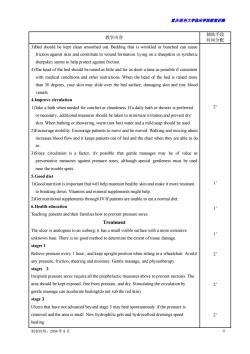
露庆医科大学临床半蕊裁案讲满 教学内容 )Bed should be kept clean smoothed ou.Bedding that is wrinkled or bunched can cause friction against skin and contribute to wound formation Lying on a sheepskin or synthetic sheepskin sms to help protect against friction. 4)The head of the bed should be raised as little and for as short a time as possible if consistent with medical conditions and other restrictions.When the head of the bed is raised more than 30 degrees.your skin may slide over the bed surface,damaging skin and tiny blood vessels. 4.Improve circulation 1)Take a bath when needed for comfort or cleanliness.If a daily bath or shower is preferred 2 measures should be taken and prevent dry skin.When bathing or showering,warm(not hot)water and a mild soap should be used. 2)Encourage mobility patients to move and be moved.Walking and moving abou increases blood flow and it keeps patients out of bed and the chair when they are able to do 3)Since circulation is a factor,it's possible that gentle massages may be of value as preventative measures against pressure sores although special gentleness must be us near the trouble spots. 5.Good diet 1)Good nutrition is important that will help maintain healthy skin and make it more resistant to breaking down.Vitamins and mineral supplements might help. 2)Get nutritional supplements through iv if patients are unable to eat a normal diet. 6.Health education 1 Teaching patients and their families how to prevent pressure sores Treatment The ulcer is analogous to an iceberg.it has a small visible surface with amore extensive 1 nknown base.There is no good method to determine the extent of tissue damage. stages 1 Relieve pressure every1 hour.and keep upright position when sitting ina wheelchair.Avoild 2 any pressure,friction,shearing and moisture.Gentle massage,and physiotherapy. stages 2 Incipient pressure sores require all the prophylactic measures above to prevent necrosis.The area should be kept exposed free from pressure,and dry.the 2 gentle massage can accelerate healing(do not rub the red skin). stage 3 Ulcers that have not advanced bevond stage 3 may heal spontaneously if the pressure is removed and the area is small.New hydrophilic gels and hydrocolloid dressings speed 2 healing. 制表时间:2004年8月
重庆医科大学临床学院教案讲稿 制表时间:2004 年 8 月 4 教学内容 辅助手段 时间分配 3)Bed should be kept clean smoothed out. Bedding that is wrinkled or bunched can cause friction against skin and contribute to wound formation. Lying on a sheepskin or synthetic sheepskin seems to help protect against friction. 4)The head of the bed should be raised as little and for as short a time as possible if consistent with medical conditions and other restrictions. When the head of the bed is raised more than 30 degrees, your skin may slide over the bed surface, damaging skin and tiny blood vessels. 4.Improve circulation 1)Take a bath when needed for comfort or cleanliness. If a daily bath or shower is preferred or necessary, additional measures should be taken to minimize irritation and prevent dry skin. When bathing or showering, warm (not hot) water and a mild soap should be used. 2)Encourage mobility. Encourage patients to move and be moved. Walking and moving about increases blood flow and it keeps patients out of bed and the chair when they are able to do so. 3)Since circulation is a factor, it's possible that gentle massages may be of value as preventative measures against pressure sores, although special gentleness must be used near the trouble spots. 5.Good diet 1)Good nutrition is important that will help maintain healthy skin and make it more resistant to breaking down. Vitamins and mineral supplements might help. 2)Get nutritional supplements through IV If patients are unable to eat a normal diet. 6.Health education Teaching patients and their families how to prevent pressure sores. Treatment The ulcer is analogous to an iceberg; it has a small visible surface with a more extensive unknown base. There is no good method to determine the extent of tissue damage. stages 1 Relieve pressure every 1 hour., and keep upright position when sitting in a wheelchair. Avoild any pressure, friction, shearing and moisture. Gentle massage, and physiotherapy. stages 2 Incipient pressure sores require all the prophylactic measures above to prevent necrosis. The area should be kept exposed, free from pressure, and dry. Stimulating the circulation by gentle massage can accelerate healing(do not rub the red skin). stage 3 Ulcers that have not advanced beyond stage 3 may heal spontaneously if the pressure is removed and the area is small. New hydrophilic gels and hydrocolloid dressings speed healing. 2’ 1’ 1’ 1’ 2’ 2’ 2’
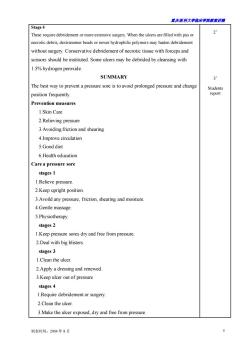
重庆医科大半床半院载未讲满 Stage 4 Theserequire debridementor surgery.When the filled with puso 2 necrotic debris,dextranomer beads or newer hydrophilic polymers may hasten debridement without surgery.Conservative debridement of necrotic tissue with forceps and scissors should be instituted.Some ulcers may be debrided by cleansing with 1.5%hydrogen peroxide. SUMMARY 3 The best way to prevent a pressure sore is to avoid prolonged pressure and change position frequently. Prevention measures 1.Skin Care 2.Relieving pressure 3.Avoiding friction and shearing 4.Improve circulation 5.Good diet 6.Health education Care a pressure sore stages 1 1.Relieve pressure. 2.Keep upright position 3.Avoild any pressure,friction,shearing and moisture 4.Gentle massage 5.Physiotherapy. stages2 1.Keep pressure sores dry and free from pressure. 2.Deal with big blisters stages3 1.Clean the ulcer. 2.Apply a dressing and renewed 3.Keep ulcer out of pressure stages 4 1.Require debridement or surgery. 2.Clean the ulcer. 3.Make the ulcer exposed,dry and free from pressure. 制表时间:2004年8月
重庆医科大学临床学院教案讲稿 制表时间:2004 年 8 月 5 Stage 4 These require debridement or more extensive surgery. When the ulcers are filled with pus or necrotic debris, dextranomer beads or newer hydrophilic polymers may hasten debridement without surgery. Conservative debridement of necrotic tissue with forceps and scissors should be instituted. Some ulcers may be debrided by cleansing with 1.5% hydrogen peroxide. SUMMARY The best way to prevent a pressure sore is to avoid prolonged pressure and change position frequently. Prevention measures 1.Skin Care 2.Relieving pressure 3.Avoiding friction and shearing 4.Improve circulation 5.Good diet 6.Health education Care a pressure sore stages 1 1.Relieve pressure. 2.Keep upright position. 3.Avoild any pressure, friction, shearing and moisture. 4.Gentle massage. 5.Physiotherapy. stages 2 1.Keep pressure sores dry and free from pressure. 2.Deal with big blisters stages 3 1.Clean the ulcer. 2.Apply a dressing and renewed. 3.Keep ulcer out of pressure stages 4 1.Require debridement or surgery. 2.Clean the ulcer. 3.Make the ulcer exposed, dry and free from pressure. 2’ 3’ Students report
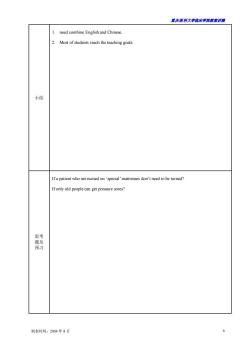
君庆医科大学脑床半院表来讲测 need combine English and Chinese. 1. Most of students reach the teaching goals. 小结 fa patient who are nursed onspecial'mattresses don'tneed to be tured? Ifonly old people can get pressure sores? 器 制表时间:2004年8月 6
重庆医科大学临床学院教案讲稿 制表时间:2004 年 8 月 6 小结 1. need combine English and Chinese. 2. Most of students reach the teaching goals. 思考 题及 预习 If a patient who are nursed on ‘special’ mattresses don’t need to be turned? If only old people can get pressure sores?
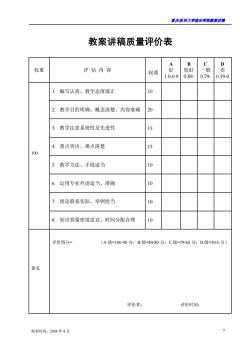
重庆医科大学临床学院教案讲满 教案讲稿质量评价表 B C 权重 评估内容 权重 好 较好 一般 差 1.0-0.9 0.89- 0.79- 0.59-0 1. 编写认真、教学态度端正 10 2.教学目的明确、概念清楚、内容准确 20 3.教学注意系统性及先进性 15 4. 重点突出、难点清楚 15 100 5. 教学方法、手段适当 10 6.运用专业外语适当、准确 10 7.理论联系实际、举例恰当 10 8. 知识容量密度适宜、时间分配合理 10 评价得分= (A级=100-90分:B级=89-80分:C级=79-60分:D级=59-0分) 意见 评价者: 评价时间: 制表时间:2004年8月 7
重庆医科大学临床学院教案讲稿 制表时间:2004 年 8 月 7 教案讲稿质量评价表 权重 评 估 内 容 权重 A 好 1.0-0.9 B 较好 0.89- C 一般 0.79- D 差 0.59-0 100 1. 编写认真、教学态度端正 10 2. 教学目的明确、概念清楚、内容准确 20 3. 教学注意系统性及先进性 15 4. 重点突出、难点清楚 15 5. 教学方法、手段适当 10 6. 运用专业外语适当、准确 10 7. 理论联系实际、举例恰当 10 8. 知识容量密度适宜、时间分配合理 10 意见 评价得分= (A 级=100-90 分;B 级=89-80 分;C 级=79-60 分;D 级=59-0 分) 评价者: 评价时间:
按次数下载不扣除下载券;
注册用户24小时内重复下载只扣除一次;
顺序:VIP每日次数-->可用次数-->下载券;
- 重庆医科大学:《护理学基础》课程教学资源(授课教案)第十一章 无菌技术.doc
- 重庆医科大学:《护理学基础》课程教学资源(授课教案)第十一章 感染预防与控制.doc
- 重庆医科大学:《护理学基础》课程教学资源(授课教案)第十章 舒适与安全.doc
- 重庆医科大学:《护理学基础》课程教学资源(授课教案)第九章 运送法、卧位示教.doc
- 重庆医科大学:《护理学基础》课程教学资源(授课教案)第九章 病人入出院护理.doc
- 重庆医科大学:《护理学基础》课程教学资源(授课教案)第八章 环境.doc
- 重庆医科大学:《护理学基础》课程教学资源(授课教案)第七章 护理程序.doc
- 重庆医科大学:《护理学基础》课程教学资源(授课教案)第六章 护理专业与法律第九章 运送法、卧位示教.doc
- 重庆医科大学:《护理学基础》课程教学资源(授课教案)第五章 护士与病人.doc
- 重庆医科大学:《护理学基础》课程教学资源(授课教案)第四章 卫生服务体系.doc
- 重庆医科大学:《护理学基础》课程教学资源(授课教案)第三章 护理学理论及相关理论.doc
- 重庆医科大学:《护理学基础》课程教学资源(授课教案)第二章 基本概念2/2.doc
- 重庆医科大学:《护理学基础》课程教学资源(授课教案)第二章 基本概念1/2.doc
- 重庆医科大学:《护理学基础》课程教学资源(授课教案)第一章 绪论.doc
- 重庆医科大学:《护理学基础》课程教学大纲(共二十二章).doc
- 重庆医科大学:《临床生物化学检验技术》课程教学大纲(供四年制医学检验技术专业使用).doc
- 重庆医科大学:《临床检验仪器学》教学大纲(供医学检验、预防医学、医学影像学、生物医学工程等专业本科学生使用).doc
- 重庆医科大学:《儿科学》课程教学大纲.doc
- 《核医学》课程电子教案(PPT教学课件)第十四章 泌尿与生殖系统(中山大学:蒋宁一).ppt
- 《核医学》课程电子教案(PPT教学课件)第十三章 肿瘤(首都医科大学:王铁).ppt
- 重庆医科大学:《护理学基础》课程教学资源(授课教案)第十三章 休息与活动.doc
- 重庆医科大学:《护理学基础》课程教学资源(授课教案)第十四章 生命体征的评估与护理.doc
- 重庆医科大学:《护理学基础》课程教学资源(授课教案)第十五章 冷热护理.doc
- 重庆医科大学:《护理学基础》课程教学资源(授课教案)第十七章 排泄.doc
- 重庆医科大学:《护理学基础》课程教学资源(授课教案)第十七章 排便护理.doc
- 重庆医科大学:《护理学基础》课程教学资源(授课教案)第十八章 药疗.doc
- 重庆医科大学:《护理学基础》课程教学资源(授课教案)第十八章 注射法.doc
- 重庆医科大学:《护理学基础》课程教学资源(授课教案)第十八章 过敏试验.doc
- 重庆医科大学:《护理学基础》课程教学资源(授课教案)第十九章 静脉输液.doc
- 重庆医科大学:《护理学基础》课程教学资源(授课教案)第二十一章 危重病人抢救.doc
- 重庆医科大学:《护理学基础》课程教学资源(授课教案)第二十二章 临终关怀.doc
- 重庆医科大学:《护理学基础》课程教学资源(授课教案)第二十三章 医疗和护理文件记录.doc
- 重庆医科大学:《护理学基础》课程实验教学指导书(共十八个实验).doc
- 《护理学基础》课程各章作业习题(共二十二章,含参考答案).doc
- 重庆医科大学:《护理学基础》课程教学资源(试卷习题)普本、涉外《护基》试题A.doc
- 重庆医科大学:《护理学基础》课程教学资源(试卷习题)普本、涉外《护基》试题A卷答案.doc
- 重庆医科大学:《护理学基础》课程教学资源(试卷习题)普本、涉外《护基》试题B.doc
- 重庆医科大学:《护理学基础》课程教学资源(试卷习题)普本、涉外《护基》试题B卷答案.doc
- 重庆医科大学:《护理学基础》课程教学资源(试卷习题)普本、涉外《护基》下试题A.doc
- 重庆医科大学:《护理学基础》课程教学资源(试卷习题)普本、涉外《护基》下试题A卷答案.doc
